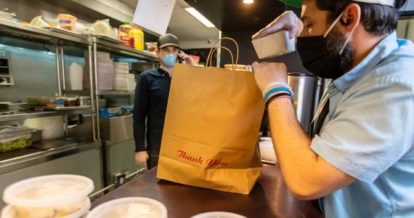While running an off-premise restaurant isn’t exactly a new idea, the pandemic has made off-premise dining a much more lucrative revenue stream than in the past.
Early on in the pandemic, the shift to off-premise was necessary for many restaurants to simply stay afloat. As mandatory dining room closures took effect and strict limits on capacity were put in place, off-premise channels such as drive-thru, takeout, and delivery became one of the few ways for restaurants to remain open for business. Of these channels, curbside takeout was the most popular, with 67% of operators adding this option since the start of the pandemic.
Even long after dining room restrictions have been lifted, off-premise dining has remained popular. Datassential found that at least half of all diners have gotten some form of takeout since the pandemic began, and the National Restaurant Association reports that seven out of 10 operators say off-premises sales represent a higher proportion of their total business compared to pre-pandemic levels.
With takeout and delivery expected to bring in the bulk of revenue for the foreseeable future, investing in off-premise dining is clearly a smart business move for operators of all types of restaurants.
So to help you master the tricky business of running an off-premise restaurant, we’ve created this ultimate guide that covers:
- What is off-premise dining
- The benefits of this type of dining
- The challenges it presents
- How to run a successful off-premise restaurant
- Tips to increase off-premise sales
Whether you’re simply looking to increase your off-premise sales, or you’re looking to fully pivot from on-site dining to an off-premise restaurant, this ultimate guide will cover everything you need to know.
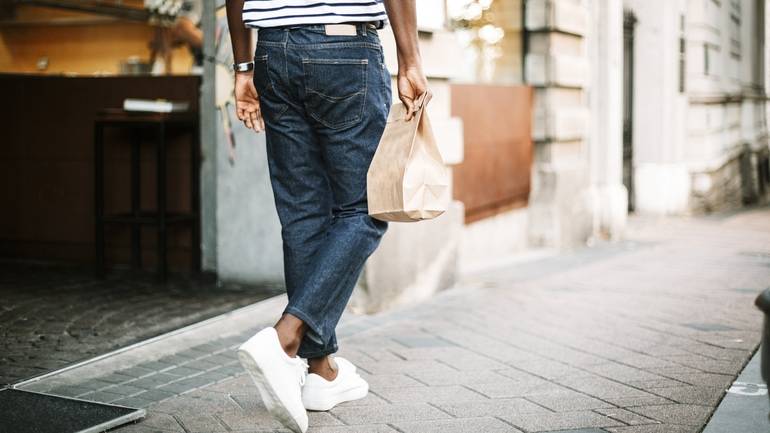
What Is Off-Premise Dining?
Before diving into the nitty-gritty of running an off-premise restaurant, it’s important to get one important question out of the way: what is off-premise dining?
Off-premise dining refers to meals that are ordered from your restaurant, but consumed elsewhere. It can take many different forms, including:
- Drive-thru: Meals are ordered and picked up from a drive-thru window (or a makeshift drive-thru system) set up at your restaurant.
- Takeout: Orders are placed ahead of time or on the spot. The food is then picked up from inside the restaurant and taken away to be enjoyed elsewhere.
- Curbside pickup/delivery: Customers order ahead and then drive to the restaurant. When the order is ready, a staff member delivers the order directly to the customer waiting in their car.
- Delivery: Orders are placed ahead of time and delivered directly to the customer’s home. In the case of no-contact delivery, no physical contact is made between the delivery driver and the customer.
Most restaurants offer at least one type of off-premise dining, in addition to on-premise dining (which refers to any meals enjoyed inside your restaurant or on your restaurant’s patio).
However, an off-premise restaurant – sometimes known as a ghost restaurant – refers to venues that only offer off-premise dining in one form or another. Becoming an off-premise restaurant can be a temporary change or a permanent one if you decide to do away with dine-in service permanently.
The Benefits of Running an Off-Premise Restaurant
Until recently, off-premise dining was generally considered a bonus revenue stream for restaurants – a savvy business move to supplement on-premise sales. In other words, a restaurant might have offered takeout and delivery, but the bulk of its revenue still came from the customers actually dining in the restaurant or sitting on the patio.
However, times have changed and the pandemic has transformed off-premise dining from a bonus, into a very necessary part of your business – in some cases, it might be the only option available.
While the pandemic may have been the impetus for this shift, off-premise dining continues to offer a lot of business benefits.
1. Growing Demand
In the past few years, younger consumers have come to expect a level of technology-enabled convenience that allows them to enjoy their favorite foods whenever, and wherever they want. This shift is reflected in global delivery sales, which have more than doubled between 2014 and 2019. Then =the pandemic kicked this trend into an even higher gear. The NPD Group found that while overall restaurant traffic dropped 22% in March 2020, delivery orders increased by almost 70%.
Clearly, takeout and delivery are in high demand, and not just among young consumers. Between continued restrictions on indoor dining and lingering anxieties about eating indoors, diners of all ages have embraced takeout and delivery.
In fact, Datassential recently found that the number one thing that stopped customers from ordering from independent restaurants during early shelter-in-place restrictions was that they didn’t offer delivery. With this kind of growing demand, it’s clear that restaurants offering off-premise dining options will be the ones tapping into this incredibly valuable source of revenue.
2. Safer for Staff and Customers
As the Centers for Disease Control and Prevention (CDC) reports, COVID-19 is primarily spread among people who are in close contact (within about six feet) for a prolonged period of time. However, restaurant dining rooms are traditionally intimate and social spaces, and keeping staff and customers six feet apart indoors can be very difficult.
Off-premise dining helps to address this concern by significantly limiting face-to-face interactions between staff and customers. In fact, the CDC classifies ordering from an entirely off-premise restaurant (one that’s limited to drive-thru, delivery, take-out, and/or curb-side pickup) as the “Lowest Risk” option when it comes to visiting a restaurant.
3. Requires Less Space
One survey found that the average restaurant kitchen takes up about 30% of the total square footage of the restaurant. Though this number varies based on the type of restaurant you run, it’s safe to say that the dining area takes up a significant, if not the majority, of your restaurant space.
The most obvious benefit of being an off-premise restaurant is that there’s less of a need for actual seating. If you’re making the temporary switch to an off-premise model, this means that you can repurpose your dining area for storage or other activities such as prepping your takeout food packaging. And if you plan to run a strictly off-premise restaurant, you could even consider leasing a smaller space to save on rent.
4. Cost-Effective
The off-premise model doesn’t just help you save space; it also helps you save on other costs. First and foremost, it can help you lower labor costs because there is less of a need for front of house (FOH) staff like hosts and servers. Even if you do keep all your staff on the payroll, FOH staff can be repurposed for other roles, such as food delivery drivers.
Switching to an off-premise model can also help you save on food costs.
Generally, a restaurants’ takeout and delivery menu is a smaller, more curated version of their full menu. And with a smaller menu, there are fewer ingredients to order and a greater opportunity to order in bulk for the things that you do need. Not to mention, it’s easier to keep track of how much you need of any given ingredient or to figure out which ingredients can be cross-utilized in multiple dishes so you can reduce the financial loss of food waste.
5. Offers More Flexibility
If there is one thing that restaurateurs can take away from 2020, it’s that things can change on a dime, and a flexible and adaptable business model is key to long-term success.
The off-premise model is perfectly suited to long-term growth because it offers restaurateurs a unique level of flexibility. With a takeout and delivery model, restaurants can easily experiment with offerings that don’t fit the usual sit-down dinner format, like meal kits, to-go cocktails, and even groceries.
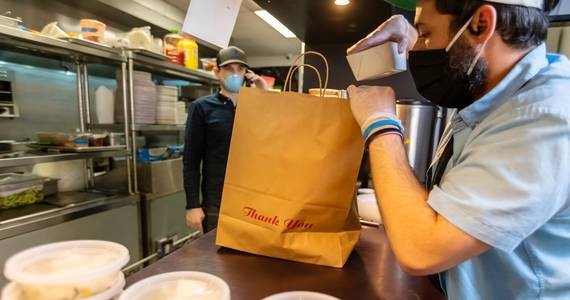
The Challenges of Running an Off-Premise Restaurant
Based on the above, shifting your focus might seem like a no-brainer. However, running an off-premise restaurant or even adding takeout and delivery channels to your existing business come with its own set of challenges.
1. Not All Food Travels Well
Some foods were born for delivery, like pizza, deli sandwiches, and noodle dishes. However, many restaurants specialize in cuisines that don’t lend themselves to takeout or a restaurant delivery service.
Just think of how difficult it is to keep a perfectly cooked steak tasting fresh after placing it in a plastic container, or keeping eggs benedict from going cold after 20 minutes in transit. And these issues are a real concern for restaurants with 60% of diners reporting that the quality, freshness, and temperature of their food is “the most critical factor in ordering delivery.”
2. The High Cost of Offering Delivery
While it’s true that off-premise dining can help you save on things like food and labor, there are some costs associated with offering takeout and delivery as well.
For many restaurants, it’s the cost of using third-party apps, like Uber Eats and DoorDash, that causes them to reconsider offering takeout and delivery. Even the best food delivery app companies will take deep cuts of each meal delivered, which means you have to have a high volume of orders to see any real profit. On average, most restaurants report paying 15% and 30% of the total order price in fees, which is a major chunk of their profits.
3. More Competition Among Restaurants
Prior to the COVID-19 pandemic, there were many operators who avoided off-premise dining in favor of their on-premise business. However, with restrictions on indoor dining forcing many restaurants to change their tune, the number of venues offering takeout and delivery has skyrocketed.
As the National Restaurant Association reports, 67% of operators have added curbside takeout since the beginning of the COVID-19 outbreak in March, while 27% have added third-party delivery, and 17% have added in-house delivery – all of which adds up to a lot more competition in the takeout and delivery space.
4. Less Control Over the Guest Experience
Lastly, if you’re considering running an off-premise restaurant, you’ll need to contend with the fact that you’ll have less control over the guest experience. Unlike traditional, in-person dining, off-premise offers fewer opportunities to wow customers with your ambiance, chef plating, or world-class customer service. Once the meal leaves your restaurant, brand control is out of your hands.
How to Run an Off-Premise Restaurant or Add Off-Premise Dining Channels
After weighing the pros and cons of this model, you might be ready to add off-premise dining channels to your restaurant. Or you might be considering running an entirely off-premise restaurant. Whatever model you choose, we’ve broken down how to do it.
1. Create a Plan
First things first, you need to start with a plan. Running an off-premise restaurant is very different from offering traditional dine-in service, so it’s important to know what you’re getting into.
Before adding any off-premise dining channels to your restaurant, consider how the following may impact your off-premise strategy:
- Venue Type: If you operate a QSR, transitioning to an entirely off-premise restaurant will be right in line with your current brand. However, if you run an FSR, things might be more complicated. Consider your brand and the best way to translate the sit-down experience into an off-premise dining experience.
- Customers: Think about your target audience and their buying habits. According to one Canadian study, those under the age of 35 frequently order delivery, while customers 35 and older tend to prefer pickup – stats that could change the type of off-premise channel you choose to offer.
- Location: Consider how accessible your restaurant is by foot or by car, and how that will impact takeout and delivery. Available parking space can also be a factor if you’re considering curbside pickup/delivery options.
After considering the above, you’ll need to choose what type of off-premise model is right for you. If you’re still offering dine-in service, you may choose to add just pickup, just delivery, or both. On the other hand, you might choose to eliminate on-site dining altogether and focus exclusively on takeout and delivery. There’s no one-size-fits-all model, so it just comes down to choosing the right option for your restaurant.
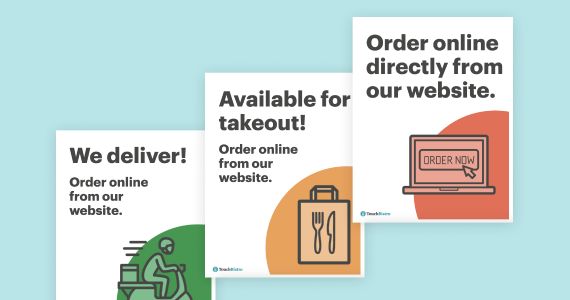
Let your customers know how to order takeout and delivery from you.
2. Invest in the Right Technology
No matter what off-premise model you choose, you’ll need the right technology to accept and process those orders. This kind of technology generally comes down to three different options:
1. Online Ordering Software
According to 2020 data from Sense360, 63% of consumers prefer to order delivery directly from the restaurant, versus 18% who prefer third-party apps.
With this growing interest in ordering directly from restaurants, the most important piece of takeout and delivery technology to consider is online ordering software like TouchBistro Online Ordering. This type of system lives on your restaurant’s website and allows customers to order takeout and delivery from you directly – 100% commission-free. The order is then processed directly through your POS system and sent straight to your kitchen. With this type of online ordering system, your restaurant is also listed on an online marketplace like TouchBistro Dine, giving you exposure to a wide variety of customers.
The biggest benefit of using a restaurant online ordering system is that there are no commission fees – a major financial gain. Plus, TouchBistro Online Ordering integrates with DoorDash Drive – a seamless delivery solution for restaurants. That means, if you don’t want to do the extra work of hiring (and insuring) your own fleet of delivery drivers, you can leverage an on-demand network of local drivers for quick and convenient delivery and pay just one flat fee per delivery order.
2. Third-Party Apps
You may also want to consider partnering with third-party apps such as Uber Eats, DoorDash, and Grubhub. Each of these apps houses an extensive list of restaurants, sorted by location and food type, so that customers can browse and order from individual menus on their phone or desktop. Some of these apps also support in-store pickup as well.
One benefit of using a third-party app is that you get to tap into the app’s existing network of delivery drivers, who will courier your meals directly to your customers. The other benefit is getting access to their marketing tools – the strategies they employ to get your restaurant in front of more users and encourage in-app ordering. The downside is that some third-party apps charge restaurants on a per transaction basis, so they take a bigger chunk of your revenue from each order.
3. Online Ordering Aggregators
Even if you go with the best food delivery service, one of the downsides of using third-party delivery apps is that each one usually needs to be managed on its own individual tablet – a situation that can lead to cluttered countertops if you’re using multiple apps.
An online ordering aggregator helps solve the problem of too many tablets by centralizing all your apps in one location: your POS. Essentially, these online ordering aggregators take all the third-party orders and streamline them directly into your POS, so you don’t have to manage more than one restaurant management system or manually enter orders.
While the obvious benefit of online ordering aggregators is operational efficiency, the downside is that these types of systems can be pricey. That’s because you have to pay per-transaction fees from both the third-party app and the integration app. As a result, an online ordering aggregator might only be a good solution if you anticipate a high volume of orders coming from multiple third-party delivery apps.
There are pros and cons to each type of takeout and delivery technology, and one option alone may not cover all your needs. In some cases, a mix of in-house and third-party technology may be the best option for your off-premise restaurant business.
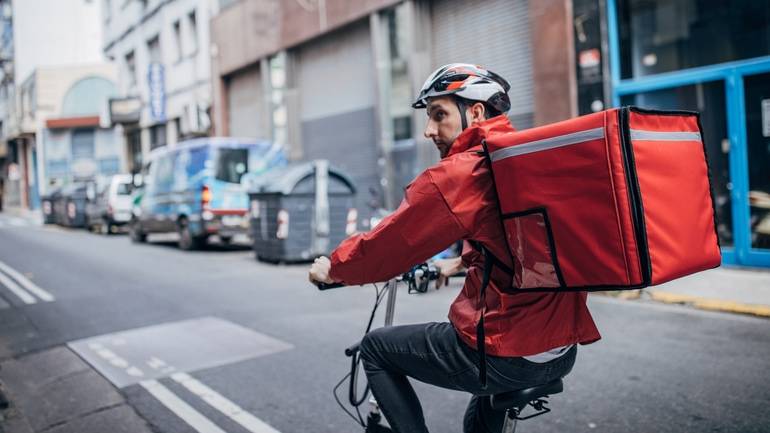
3. Optimize Your Menu
Off-premise dining isn’t the same experience as dining in, and your menu should reflect that.
While you don’t need to reinvent the wheel, you should consider creating a specific off-premise menu. An off-premise menu is generally a smaller, more condensed version of your regular menu. While it might be hard to stick to just a few dishes, a smaller menu offers some big benefits:
- Requires less staff to prepare a handful of dishes, rather than dozens of different ones.
- Lowers your overall food costs because there are fewer ingredients to buy.
- Improves the customer experience by not overwhelming diners with too many choices.
- Simplifies the online ordering experience because there are fewer items to scroll through – something that’s especially important on mobile.
When curating your new off-premise menu, you want to prioritize menu items that are popular, profitable, and deliverable.
You can measure the popularity of your current menu items by digging into historical sales data and tracking customer feedback. To measure the profitability of your current menu item, you’ll need to calculate menu item food cost and menu item food cost percentage. As for deliverability, this one will likely come down to trial and error. Test out different dishes in various takeout containers and eliminate any items that don’t hold up in transit.
Once you have a curated list of dishes that work for takeout and delivery, you’ll need to translate this information into an online menu. Unlike a print menu, your online menu should be designed for easy navigation and upselling. When building your online menu, keep the following in mind:
- Photos: Use high-quality photos to make your dishes stand out.
- Descriptions: Written descriptions should be clear and concise, but also as tempting as possible. This is also a good opportunity to list any potential allergens or defining features like locally sourced ingredients.
- Categories: Separate your menu into distinct categories like “best sellers” or “desserts” to make it easy for customers to navigate.
- Modifiers and Add-Ons: Make sure each item includes a list of extras customers can add or upgrade.
4. Train Staff
While processing takeout and delivery orders may seem easier than managing dine-in service, it’s not quite that simple. Off-premise dining is its own beast, and running a successful takeout and delivery business involves a whole different set of demands on your restaurant staff.
Front of House (FOH)
Scaling back or completely eliminating on-site dining, means you have less need for servers, hosts, and other FOH staff. In most cases, this means you’ll need to train these FOH staff members to carry out different duties, such as serving guests coming in to place and pick-up takeout orders. Your FOH staff will be responsible for managing this flow of off-premise orders, which involves regular cleaning, preventing any bottlenecks, and ensuring proper social distancing among customers.
FOH staff may also be responsible for managing delivery orders. If you’re not using a POS-integrated online ordering system, this may involve managing third-party app tablets and manually entering orders into your POS. FOH staff may also need to coordinate and hand off orders to delivery drivers.
Back of House (BOH)
While this shift will require FOH to learn entirely new workflows, BOH staff will be more focused on dealing with an increased workload. First and foremost, this will require optimizing your kitchen layout to make sure takeout and delivery orders can be prepared, cooked, and packaged quickly and efficiently – all while keeping food safety top of mind.
For BOH staff, understanding and forecasting the increase in volume of orders is necessary to avoid bottlenecks. However, it may take a few weeks of offering off-premise dining before you know how many orders to expect at a given time. While working out these kinks, make sure your online ordering platforms can be updated to reflect your current stock and your takeout/delivery capacity.
5. Create New Guest Experiences
Perhaps one of the biggest differences between running an off-premise restaurant versus an on-premise restaurant is the customer experience. Restaurants are naturally a service-oriented business and delivering someone a box of your food doesn’t give you the same opportunities to interact with guests and build long-lasting relationships.
Of course, just because your guests aren’t enjoying their meal inside your restaurant, it doesn’t mean you can’t still provide a stellar guest experience – it just takes more creativity. Some innovative ways to enhance the takeout and delivery experience, include:
- Consistent Branding: Make sure your brand identity is consistent with every part of the off-premise dining experience – from the language used on your menu, to your takeout packaging.
- Surprise & Delight: Little extras like garnishes or surprise desserts can go a long way. For instance, when Datassential asked customers what would be appealing to receive with their delivery orders, 51% of respondents said they would like mini bottles of condiments to enjoy with their meal.
- Promote Savings: Include coupons or codes for discounts on future orders to encourage repeat business.
- Get Personal: Consider adding a personal note to each order to show customers that extra care was put into their order.
Putting effort into creating a great takeout or delivery experience is especially important if you’re outsourcing some of the work to third-party apps. As one study found, 80% of consumers say they would blame the restaurant, and not the third-party delivery company, if they had a poor experience, so take extra care with each and every order.
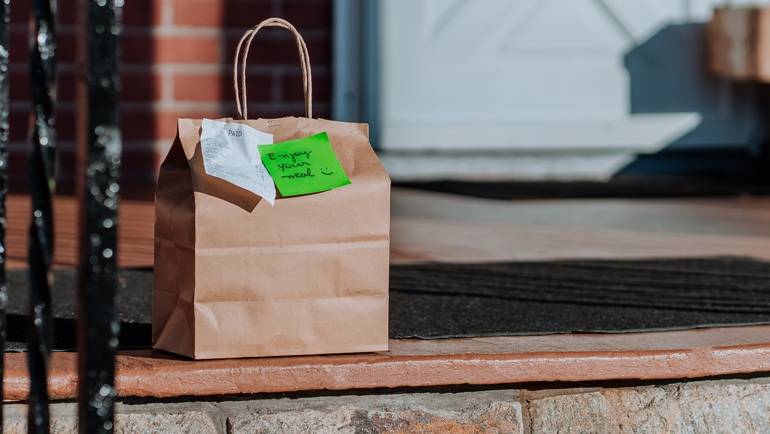
6. Market Your Off-Premise Business
Even if you add every off-premise channel under the sun – pickup, delivery, drive-thru – it won’t do any good unless your customers actually know that you offer it. To solve this conundrum, you need to think about how to market your restaurant’s off-premise dining options. While this will be different for every restaurant, there are three key areas to cover:
1. Update Your Online Presence
The easiest place to tell people about your off-premise dining options is on your online channels. On your website, make sure you’ve clearly explained what options are available to your customers (e.g. pickup, delivery, etc.), how they can order from you (e.g. by calling your restaurant, using a third-party app, etc.), and other practical information (e.g. operating hours, phone number, address, etc.). If you’re using a direct online ordering system, you can also add a button directly to your website so ordering is virtually seamless for customers.
Beyond your website, update all of your social media channels (especially Facebook and Instagram) to mention your off-premise dining options. You might also consider investing in paid ads on these platforms to get the message to new customers in your area.
Finally, consider third-party online listings like Yelp, TripAdvisor, and your Google My Business listing. Though people may not be walking by your restaurant like they used to, they are definitely searching for restaurants online so make sure they’ll find accurate information whenever they come across your restaurant.
2. Get the Word Out
According to Datassential, email is the number one way customers prefer to receive marketing updates from restaurants. So if you’ve been building up an email list over the years, now’s the time to use it.
Consider sending out an email update announcing your new off-premise dining options. In your email, be crystal clear about how customers can order takeout and/or delivery from you.
However, it shouldn’t be all business. Use your email as an opportunity to build excitement for your off-premise dining options and give customers a reason why they should visit. This can be as simple as adding some mouth-watering images of your takeout offerings, or sending out a virtual coupon.
3. Leverage Partnerships
Even if you’ve built up a loyal following over the years, you’ll want to make sure you reach new customers as well. Consider partnering with influencers who may have a large audience you can tap into. For instance, food influencer and Black Foodie founder Eden Hagos regularly features black-owned restaurants across Canada and the U.S. Or you can look for local influencers to team up with like the @chicagofoodauthority Instagram account or New York City food blogger Jackie Gebel of the No Leftovers blog.
If you have the budget for it, third-party apps are another great partnership to leverage. Most of these apps offer priority placement, promoted listings, and featured offerings that help to put your restaurant in front of a huge audience. The only catch is that you’ll have to pay for these kinds of marketing promotions, so make sure you research fees before going all-in with a third-party app.
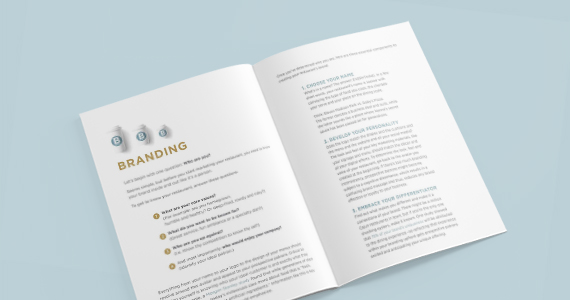
Everything you need to know about social media, digital marketing, SEO, and more!
7. Gather Insights and Optimize
After taking all of the above steps, you need to find out if your off-premise strategy is actually working and how you can improve. The best way to do this is by keeping an eye on your restaurant reports and collecting insights that will help you improve your tactics and inform your decisions in the months ahead.
Of all the essential metrics you want to track, most are already collected by your POS system. These include:
- Cost of Goods Sold (CoGS): CoGS refers to the raw material costs of your menu items – the actual amount of food and beverage used to produce your food and beverage sales. If you’re running an entirely off-premise restaurant with a limited menu, this number should drop.
- Prime Cost: Also known as your direct costs, your prime cost is the total sum of your labor costs and your CoGS – variables that may shift dramatically as your off-premise business increases. Analyzing your prime cost helps you decide how much you need to charge to make a profit, and how much you can spend without compromising your business.
- Break-Even Point: A calculation that pinpoints how much you must make in revenue to cover your restaurant’s fixed and total variable costs over a specific time period. As your off-premise business picks up, analyze your break-even point to find out how much money your business needs to generate or how many units it must sell in order to become profitable.
Of course, these are not the only restaurant metrics you should be keeping an eye on. You should also pay attention to customer habits, preferences, and behaviors – information that’s easy to track if you implement a restaurant loyalty program.
Tips to Increase Off-Premise Sales
Speaking of increasing cash flow, you should constantly be thinking of ways to boost off-premise sales as your business evolves. Though a fine dining establishment may take a different approach than a fast casual joint, here are some creative add-ons that can help increase off-premise sales.
Catering
While the pandemic slowed many opportunities for in-office, corporate catering, there are still plenty of catering opportunities out there. For instance, many essential businesses, such as warehouse workers, construction workers, and hospital workers, are in need of affordable, hearty meal options. If you’re able to target the right audience with the right kinds of options, catering could give your off-premise sales a significant boost.
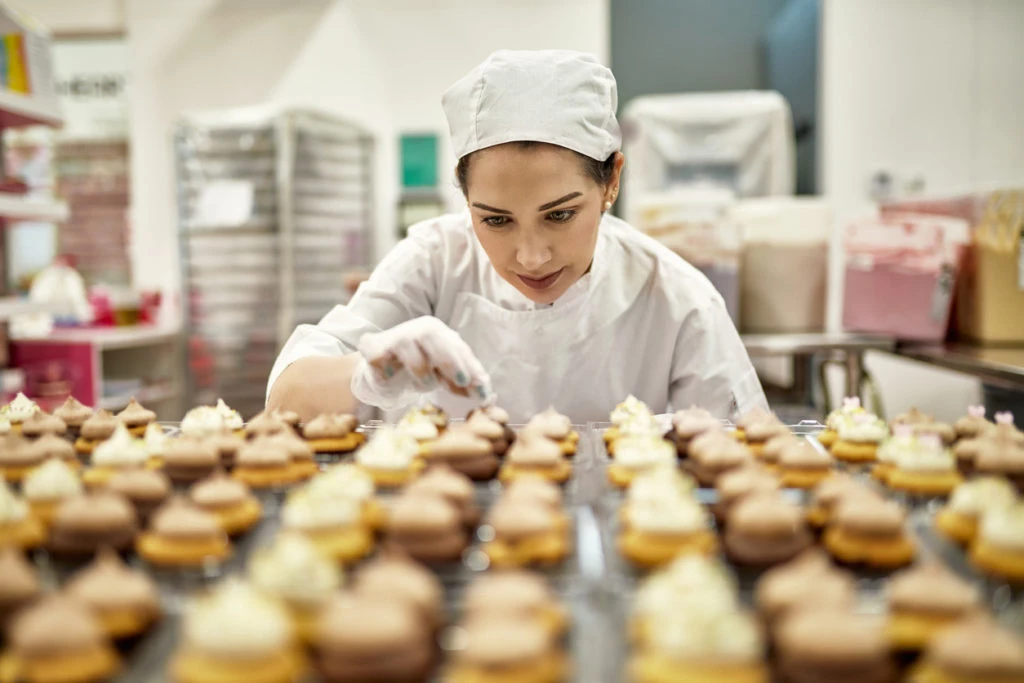
Make your catering business a reality with this customizable catering business plan template.
To-Go Alcohol
Since the pandemic began, some states and provinces have permitted alcohol delivery and pickup from restaurants. While these rules vary from one place to the next, adding alcohol to your off-premise business can be a game-changer. This is because alcohol sales often have the highest profit margins for restaurants due to large markups – sometimes upwards of four times the wholesale cost. Additionally, alcohol has a longer shelf-life than most ingredients and requires minimal labor to prepare. All this adds up to a lucrative source of revenue for restaurants able to sell alcohol to-go.
Meal Kits
Since the pandemic began, ready-to-cook meal kits for dishes such as tacos, pizza, and pasta have exploded in popularity among customers. This is a great off-premise option for restaurants because meal kits require less cook time, allowing for greater efficiency in the kitchen. Additionally, meal kits come in bigger quantities, helping to boost average check size. For instance, Canela, a Spanish bistro and wine bar in San Francisco, sells paella kits that go for up to $55 a pop. The restaurant even sells a special paella cooking pan for an extra fee.
Groceries
With consumers eating at home more than ever, offering groceries is an easy way to increase average check size for off-premise sales. For instance, the multi-venue restaurant Local Public Eatery launched a virtual grocery store called Local Corner Store that lets customers add pantry staples like bread, milk, and veggies to go along with their order of pub fare.
Though off-premise dining has been growing in popularity for quite some time, the COVID-19 pandemic has accelerated this trend in a big way. Now, adding off-premise dining channels such as takeout and delivery, or even running an entirely off-premise restaurant, is a viable business model – you just need the right strategy.
Free online ordering signs for your restaurant
Sign up for our free weekly TouchBistro Newsletter

